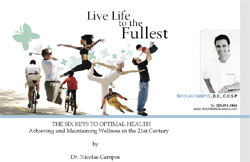 Have you ever woken up in the middle of the night with a severe leg cramp? If you have you know it's a painful situation. Sometimes you can even see the calf muscle contracting and going into spasm right before your very eyes. Unfortunately, it happens to most people at one time or another. For the most part muscle cramps are benign – that is, with a quick self massage or by simply walking it off the pain and spasm subside. Sometimes, though, it can be much more serious than that. Have you ever woken up in the middle of the night with a severe leg cramp? If you have you know it's a painful situation. Sometimes you can even see the calf muscle contracting and going into spasm right before your very eyes. Unfortunately, it happens to most people at one time or another. For the most part muscle cramps are benign – that is, with a quick self massage or by simply walking it off the pain and spasm subside. Sometimes, though, it can be much more serious than that.
A muscle cramp is a sudden, uncontrolled contraction of a muscle. Night cramps often occur in the calf muscle, and usually right before falling asleep, but many people have experienced them while in the midst of a dead slumber. They generally last about a minute or less, but can go on for a lot longer. Either way, it seems like a lifetime when a muscle is cramping.
Many things can cause leg cramps – dehydration, excess weight, medications, and overtraining to name a few – but I want to talk about a more serious form of leg cramping called a deep vein thrombosis.
Deep Vein Thrombosis
A deep vein thrombosis (DVT) is the formation of a blood clot in a deep vein, usually in the leg, but it can also form in an arm as well. Although a DVT can develop in the thigh or pelvis, the most common area for these clots to occur is – you guessed it – the calf muscle.
A DVT feels a little different from a typical leg cramp. It's more like a deep ache than a spasmodic contraction. And it's also frequently associated with swelling, discoloration, warm skin, fever and visible surface veins (varicosities).
A DVT can be caused by several things, including surgeries (particularly of the hip, leg or abdomen), pregnancy, prolonged bed rest or sitting for a long time, like when on a plane. The elderly are particularly prone to developing deep vein thromboses, but anybody can acquire them, especially if they are inactive. Clots are formed from inactivity because blood can pool in the lower legs and stagnate there. Stagnant blood clots due to clotting factors – the chemicals that stop our bleeding when we develop a wound. Why does this happen? Let's take a look.
Blood circulates in the body through blood vessels – arteries and veins. Arteries carry blood away from the heart, while veins bring blood back towards the heart. The arteries have the luxury of being helped by a large and powerful pump – the heart. The heart works tirelessly, 24/7, pumping blood to all areas of the body including the distal appendages – the arms and the legs.
The veins, however, are not so lucky. They have to rely on muscular contractions of the arms and legs. No problem. All that's required, then, is movement. It's one reason I push all my clients to keep moving . Movement is essential for so many functions, not just your looks or weight – it's like having a car that mostly sits in the garage – you've got to start it up and take it for a spin now and again, otherwise it's not going to start at all one day.
So when a body is inactive for an extended period of time – even as short as five hours, like when on a cross country flight – blood can stagnate and a clot can form. DVT is a serious situation because if a clot dislodges, it can travel up to the lungs and lodge there. This is called a pulmonary embolism and it can kill you – quickly.
The Answer Is?
If you suspect a DVT, please consult your medical doctor. There are several treatment options available, and if you catch it soon enough, it'll be relatively painless (pun intended, pun intended). But, as they say, the best cure is prevention. So, how can you prevent a DVT? Regular cardiovascular activity – running, swimming, biking, break dancing – is the way to keep your blood flowing. Weight training is also great, but I wouldn't substitute it for cardio work. And, of course, stretching – yes, stretching – and I'll say it again and again and again. You've got to do it. It's not just that it provides a multitude of benefits; it's that the disadvantages of not doing it are simply unreasonable – DVT happens to be a major one. And finally, to reiterate another adage of mine: drink lots of water. Water adds volume to your blood, and voluminous blood flows better (there, I've said it).
So, don't let a deep vein thrombosis or a blood clot cramp your style. Do cardiovascular exercises regularly, stretch, and drink plenty of water. If you are on a long flight, get up at least once an hour, walk around, and do calf raises and other airplane stretches (ask me on your next visit – I'll be happy to show you a handful). And most importantly, keep moving – it's the best medicine I know.
*Come back next month and catch Part Two of Don't Cramp Your Style.
- July 3, 2007
*COMING AUGUST 2007
The Six Keys to Optimal Health by Dr. Nicolas Campos
For More Advice on Health and Optimal Living Read
The Six Keys to Optimal Health by Dr. Nicolas Campos
COMING SOON TO A BOOKSTORE NEAR YOU

|

















